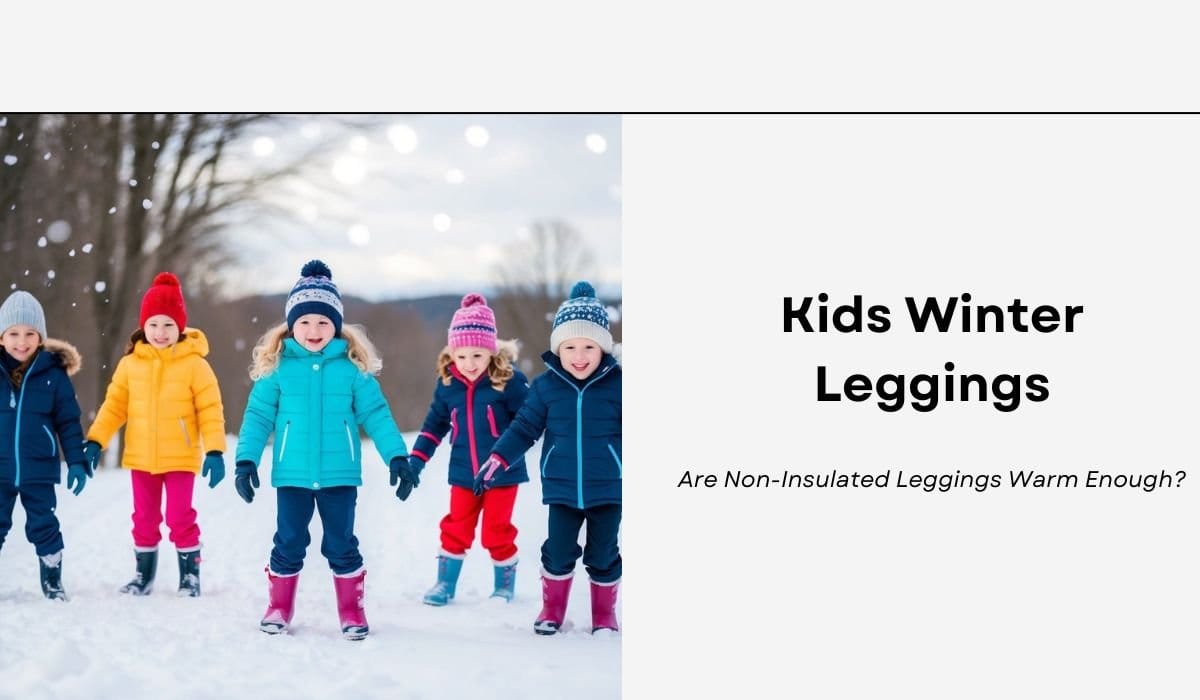The Truth About Basic Leggings in Cold Weather – What Parents Need to Know Before Winter
Winter brings chilly weather, and parents often wonder if regular leggings are enough to keep their children warm. Kids love the comfort and flexibility of leggings, but are non-insulated options up to the task of battling cold temperatures?
Non-insulated leggings alone are typically not warm enough for children in winter weather. While they can provide a basic layer of coverage, they lack the insulating properties needed to trap heat effectively. This is where layering becomes crucial for keeping little ones cosy during outdoor activities.
Proper layering with leggings can make a big difference in warmth and comfort. A base layer of thermal underwear or tights beneath regular leggings adds insulation without bulk. For extra protection against the cold, waterproof trousers or ski pants can be worn over leggings to create a snug and weather-resistant outfit.
On This Page
Key Takeaways
- Non-insulated leggings need additional layers for adequate warmth in winter
- Thermal underwear or tights underneath leggings boost insulation
- Waterproof trousers over leggings provide extra protection from cold and wet conditions
Understanding Warmth and Insulation Principles
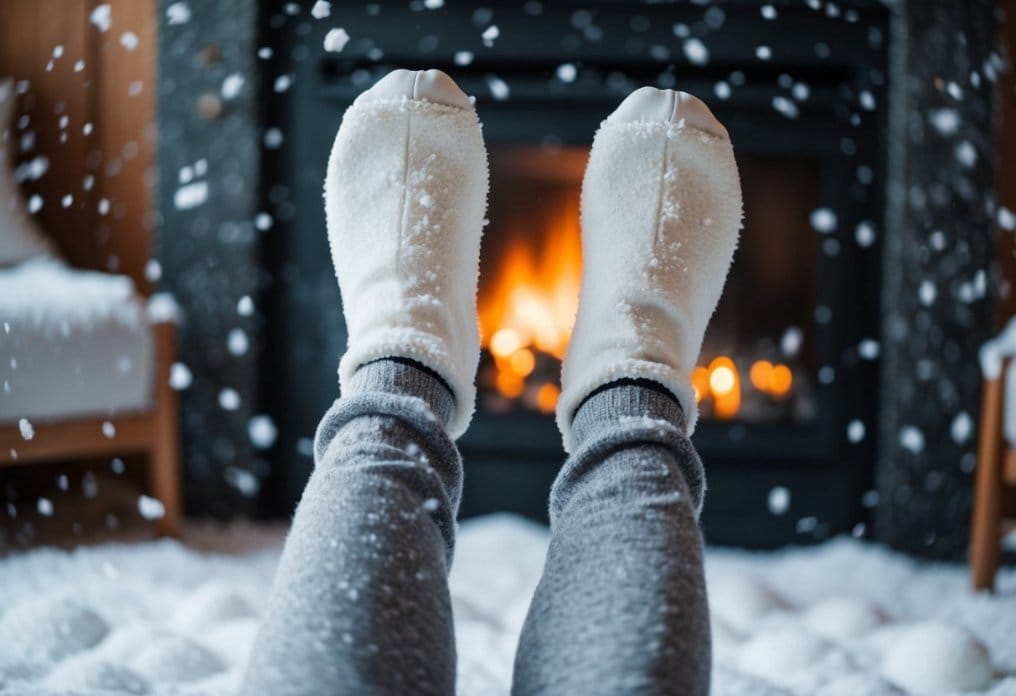
Winter leggings help keep children warm by trapping a layer of air next to the skin. This air acts as insulation, slowing heat loss from the body.
The effectiveness of leggings depends on their material and construction. Thermal leggings often use special fabrics designed to retain heat better than regular cotton or polyester.
Insulation works by creating small air pockets within the fabric. These pockets reduce heat transfer, helping maintain body temperature in cold weather.
A good base layer is key for warmth. Leggings worn close to the skin form this important first layer, wicking away moisture and providing a foundation for other clothing.
Thermal leggings typically offer more insulation than regular leggings. They may use thicker fabrics or special thermal materials to boost warmth without adding bulk.
Layering is crucial for staying warm. Leggings can be worn under trousers or snow pants for extra insulation on very cold days.
Wind resistance also matters. Some winter leggings have a tighter weave or special coating to block chilly breezes, enhancing their warming effect.
The Role of Leggings in Cold Weather Layering
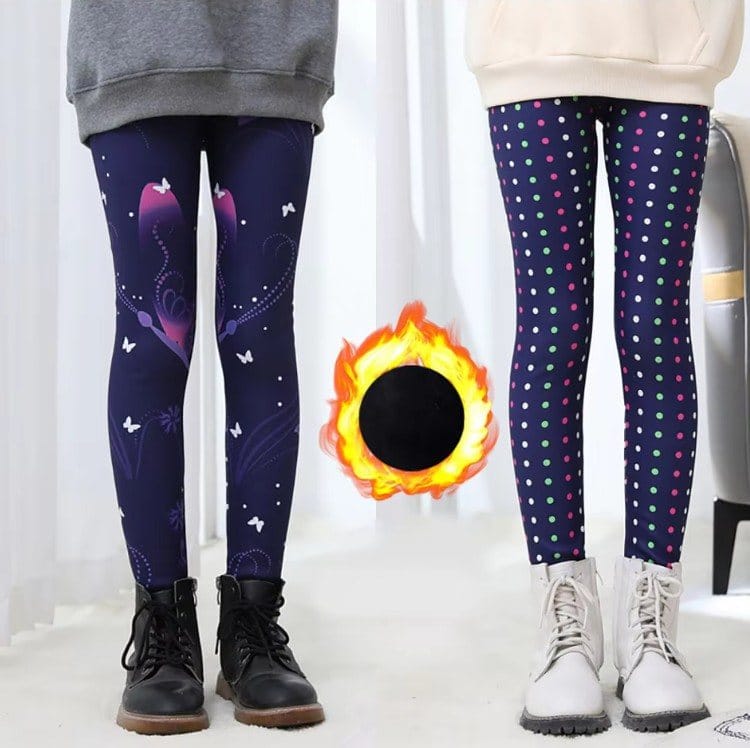
Leggings play a crucial part in keeping kids warm during winter. They serve as a versatile base layer that traps heat close to the body and wicks away moisture.
Layering Basics
Layering is key for staying cosy in cold weather. The idea is to create multiple thin layers of clothing that trap warm air between them. This approach works better than one thick layer, as it allows for easy adjustments as temperatures change.
For kids, a basic layering system includes:
- Base layer: Snug-fitting thermal underwear or leggings
- Mid layer: Fleece or wool jumper for insulation
- Outer layer: Waterproof and windproof jacket and trousers
Each layer has a specific job. The base layer manages moisture, the mid layer insulates, and the outer layer protects from wind and rain.
Leggings as a Base Layer
Leggings make an excellent base layer for children in cold weather. They fit close to the skin, trapping a thin layer of warm air next to the body. This helps maintain core body temperature.
Look for leggings made from moisture-wicking fabrics like merino wool or synthetic materials. These pull sweat away from the skin, keeping kids dry and warm. Avoid cotton, as it holds onto moisture and can make children feel cold and clammy.
For very cold days, thermal leggings or long underwear offer extra warmth. They’re designed to be worn under other clothes and provide an extra layer of insulation.
Comparing Materials: Natural vs Synthetic Fabrics
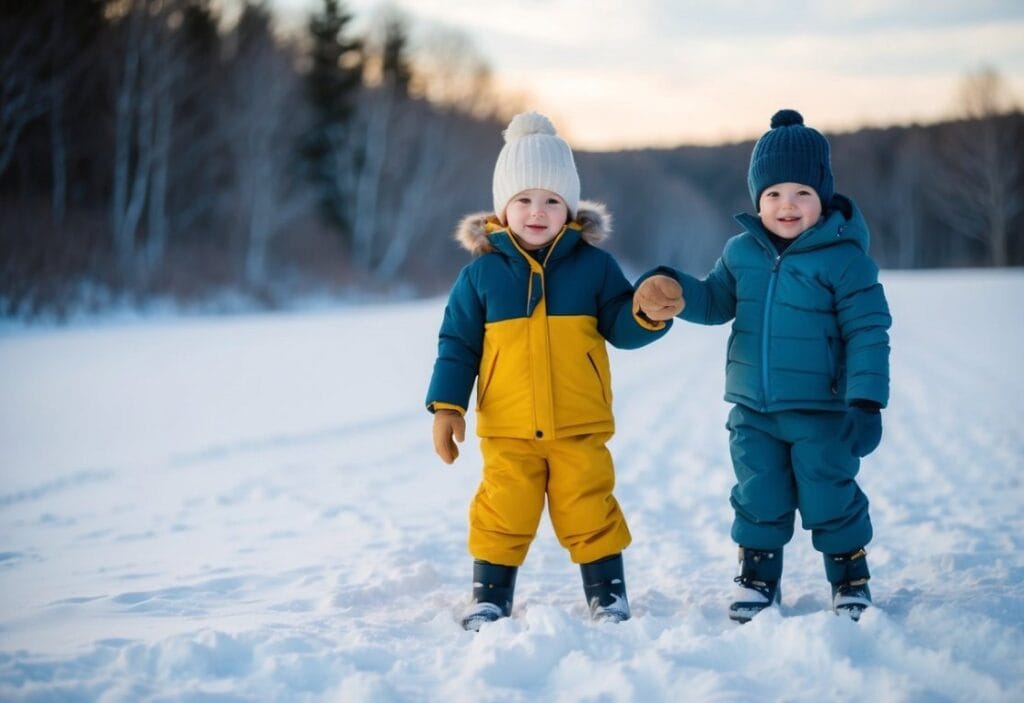
Natural and synthetic fabrics each have unique properties for winter leggings. Merino wool offers warmth and breathability, while synthetic materials like polyester provide durability and moisture-wicking.
Merino Wool Characteristics
Merino wool is a top choice for winter leggings. It’s a natural fibre that keeps kids warm even when wet. This wool is soft, not itchy like other types. It wicks moisture away from the skin, keeping children dry.
Merino wool is also odour-resistant. This means leggings stay fresher for longer, even after active play. The material is breathable, helping to regulate body temperature. This stops kids from getting too hot or cold.
One drawback is that merino wool leggings can be pricey. They also need gentle washing to keep their shape and softness.
Polyester and Other Synthetics
Polyester is a popular synthetic fabric for kids’ winter leggings. It’s strong and lasts a long time, even with rough play. Polyester dries quickly, which is great for active children.
This material is good at wicking moisture. It moves sweat away from the skin, keeping kids dry. Polyester leggings are often cheaper than natural fabrics.
Other synthetics like nylon may be mixed with polyester. This can add stretch and make leggings more comfy. Synthetic leggings are easy to care for. They can be machine washed and dried without special care.
The downside is that synthetics don’t breathe as well as natural fibres. They might make kids feel sweaty if worn for a long time.
Design Features of Leggings for Winter Activities
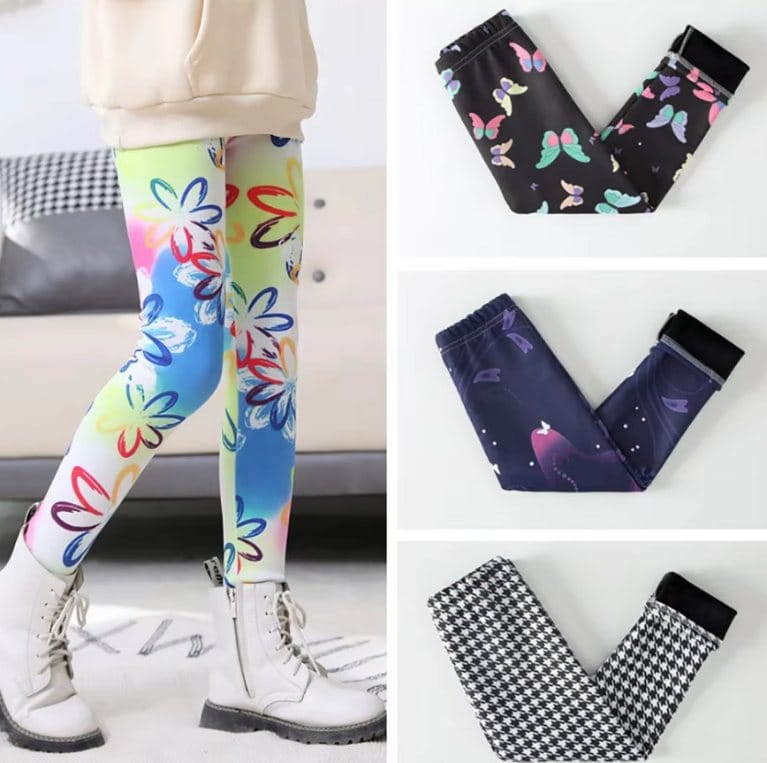
Winter leggings incorporate special features to keep kids warm and comfortable during cold-weather activities. These design elements focus on managing moisture, allowing movement, and providing a snug fit.
Moisture Management
Winter leggings use fabrics that wick sweat away from the skin. This keeps children dry and prevents chills. Many leggings have a soft inner layer to trap warmth next to the body. The outer layer repels light moisture and snow. Some leggings use merino wool, which naturally manages moisture and odour. Others use synthetic blends that dry quickly.
Materials like fleece add extra warmth without bulk. This allows kids to move freely whilst staying cosy. Breathable panels in key areas help prevent overheating during active play.
Compression and Mobility
Winter leggings often have a snug, compressive fit. This helps retain body heat and improves blood flow to cold muscles. The fabric stretches in all directions for unrestricted movement.
Reinforced knees and seat areas boost durability for active kids. Some styles have built-in knee pads for extra protection. Flat seams reduce chafing and bulk under other layers.
Elastic waistbands keep leggings in place during play. Many have adjustable drawstrings for a custom fit as children grow.
Cuffs and Fit
Cuffs play a key role in winter legging design. Snug ankle cuffs keep cold air out and prevent snow from getting inside boots. Some cuffs have silicone grips to hold them in place.
Longer lengths provide extra coverage between socks and boots. Some styles have stirrups that go under the foot for a secure fit inside boots.
Tapered legs reduce bunching inside snow boots and ski pants. This improves comfort and prevents gaps where cold can enter.
Waterproof Versus Water-Resistant Leggings
Kids’ winter leggings come in both waterproof and water-resistant options. Each type offers different levels of protection against moisture.
Waterproof Technologies
Waterproof leggings use special fabrics and coatings to block out all water. They often have sealed seams to prevent leaks. Some use breathable membranes like Gore-Tex that keep water out while letting sweat escape.
Waterproof shell layers are common in ski and snowboard trousers. These outer layers shed snow and rain completely. They’re ideal for very wet conditions or playing in deep snow.
Fully waterproof leggings can be less flexible than other types. They may feel stiffer and make more noise when moving.
Assessing Water Resistance
Water-resistant leggings offer some protection from light rain or snow. They use treatments like DWR (durable water repellent) to make water bead up and roll off.
These leggings work well for brief exposure to moisture. They’re more breathable and flexible than waterproof options. Water-resistant leggings are good for light rain or brief snow play.
Quick-drying fabrics help water-resistant leggings perform better. Even if they get damp, they dry fast to keep kids comfortable. Look for synthetic materials like nylon or polyester for the best quick-drying properties.
Integration with Other Winter Gear
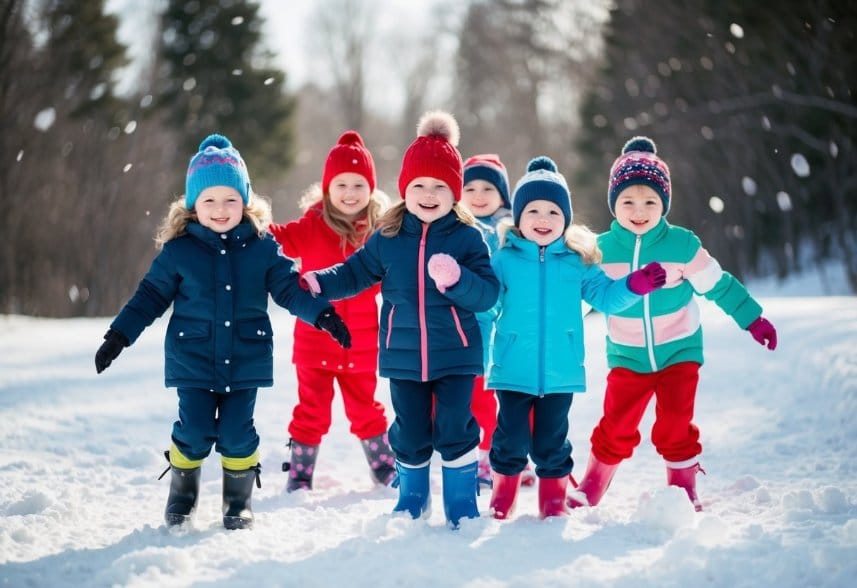
Kids’ winter leggings work well with other cold-weather clothing. They form a key base layer that pairs nicely with outer garments for maximum warmth and protection.
Matching with Snow Pants
Snow pants are a must for snowy activities. Leggings fit snugly underneath, adding extra insulation. This combo keeps kids warm and dry during sledding or snowball fights.
Look for snow pants with adjustable waists and leg cuffs. These features help seal out cold air and snow. Some brands offer matching sets of leggings and snow pants for a coordinated look.
For very cold days, choose fleece-lined leggings as the base layer. This provides more warmth than standard leggings under snow pants.
Adding Insulated Ski Pants
Ski pants offer more protection for winter sports. They’re designed to be waterproof and windproof. Leggings worn underneath add an extra layer of warmth without bulk.
Choose thin, moisture-wicking leggings for skiing. This helps move sweat away from the skin. Merino wool leggings are a top choice for their warmth and odour-resistant properties.
Many ski pants have built-in gaiters. These fit over ski boots to keep snow out. Make sure leggings are long enough to tuck into boots and gaiters comfortably.
Complementary Outerwear
Leggings pair well with various types of outerwear. A long puffer coat or parka works great for everyday winter wear. The coat should cover the hips to keep the leggings-clad legs warm.
For active play, pair leggings with a waterproof shell jacket. This combo allows for easy movement while protecting against wind and rain.
Don’t forget accessories. Warm socks, boots, gloves, and a hat complete the winter outfit. Choose items that overlap with leggings and outerwear to prevent cold spots.
Leggings in Winter Sports: Skiing and Snowboarding
Leggings play a key role in skiing and snowboarding gear. They form the base layer that keeps legs warm and dry on the slopes.
For skiing and snowboarding, thermal leggings are a must. They trap heat close to the body and wick away sweat. This helps maintain a comfortable body temperature during cold-weather activities.
Many brands offer specialised ski and snowboard leggings. These often have extra features like:
- Seamless design for reduced chafing
- Breathable panels for ventilation
- Reinforced knees for durability
Decathlon sells kids’ ski thermal base layer leggings. These come in different colours and are designed for comfort on the slopes.
It’s important to layer properly when skiing or snowboarding. Thermal leggings go under ski trousers or snowboard pants. This combo provides warmth and protection from the elements.
For young skiers and snowboarders, the right leggings can make a big difference. They help kids stay warm and focused on having fun rather than feeling cold.
When choosing leggings for winter sports, look for:
- Moisture-wicking fabrics
- Snug but not tight fit
- Flexibility for easy movement
With the right thermal leggings, children can enjoy skiing and snowboarding in comfort all day long.
Kids’ Winter Leggings for Everyday Use
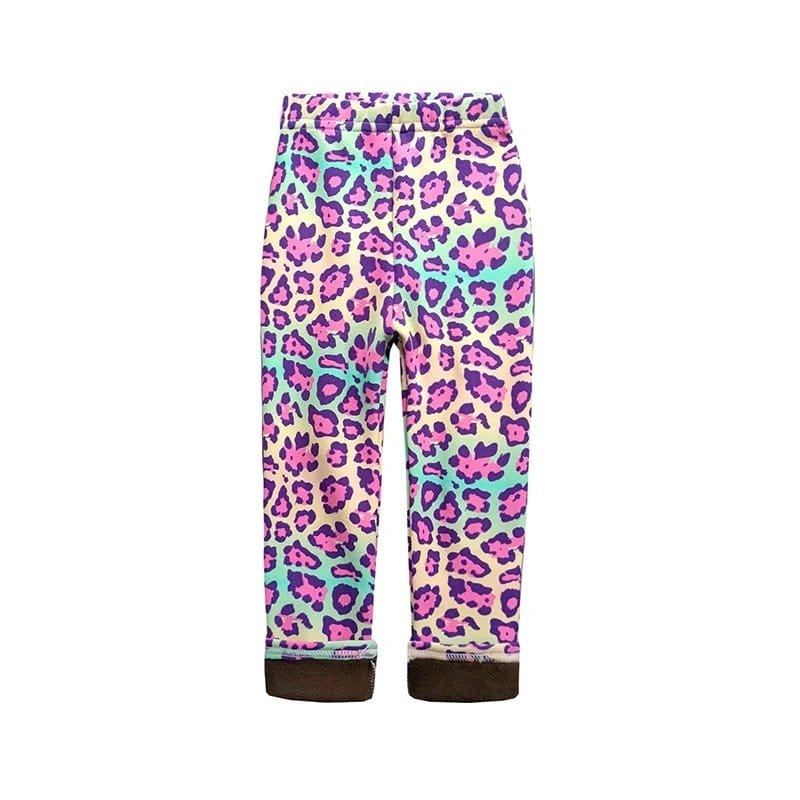
Winter leggings are a versatile choice for children’s cold-weather wardrobes. They offer warmth and comfort for everyday activities, from playing outdoors to going to school.
Many brands make thermal leggings specifically for kids. These often have fleece or brushed interiors to trap heat close to the body. Some popular options include John Lewis Kids’ Thermal Leggings and H&M’s fleece-lined styles.
For extra warmth, layering is key. Children can wear regular leggings under trousers or snow pants for outdoor play. This combo works well for winter activities like sledding.
Here’s a quick guide to layering leggings:
- Base layer: Thermal or wool leggings
- Mid layer: Regular leggings or tights
- Outer layer: Waterproof trousers (if needed)
Cotton leggings aren’t ideal for cold days. They don’t insulate well when wet. Instead, look for synthetics or wool blends that wick moisture away from the skin.
For everyday wear, thick leggings in dark colours are practical. They hide dirt and pair easily with different outfits. Patterns and bright shades can add fun to dreary winter days.
Remember to choose the right size. Leggings should fit snugly without being too tight. This ensures proper insulation and allows for comfortable movement during active play.
Caring for Kids’ Winter Leggings
Proper care of children’s winter leggings helps them last longer and stay warm. Good washing and drying practices keep leggings in top shape for many cold seasons.
Proper Washing Techniques
To clean kids’ winter leggings, turn them inside out before washing. This protects the outer fabric and helps remove sweat and skin cells. Use cold water and a gentle cycle to avoid shrinkage and damage.
Choose a mild detergent made for delicate fabrics. Avoid harsh chemicals or bleach, as these can break down the fibres. For tough stains, spot-treat before washing.
Don’t overload the machine. Give leggings space to move freely in the wash. This allows for better cleaning and less wear and tear.
Drying and Storage
After washing, avoid using a tumble dryer for most winter leggings. High heat can damage elastic and insulating materials. Instead, hang leggings to air dry.
For quick-drying, lay leggings flat on a towel. Roll the towel up to squeeze out extra water, then unroll and reshape the leggings. Hang them in a well-ventilated area away from direct heat sources.
Once dry, fold leggings neatly and store in a cool, dry place. Avoid cramming them into tight spaces, as this can stretch the fabric. For long-term storage, place leggings in a breathable cloth bag to protect from dust and pests.
When to Choose Insulated Leggings Over Non-Insulated
Insulated leggings are the better choice when temperatures drop below freezing. They provide extra warmth for outdoor winter activities like sledding or building snowmen.
For very cold days, pair insulated leggings with windproof snow pants. This combo keeps kids cosy even in harsh weather. The insulation traps body heat while the outer layer blocks icy winds.
Non-insulated leggings work well for milder winter days or indoor play. But once the mercury dips, insulated options shine. They’re ideal for:
• Prolonged outdoor time • Snow play • Skiing or snowboarding • Frigid mornings at the bus stop
Insulated leggings also excel as a base layer under snow pants. This setup offers maximum warmth for extreme cold or all-day outdoor adventures.
When shopping, look for leggings with thermal or fleece lining. These materials add crucial warmth without bulk. Water-resistant options help keep kids dry in wet snow.
For active kids, breathable insulated leggings prevent overheating. They wick away sweat while maintaining warmth. This balance is key for comfort during winter sports or energetic play.
Frequently Asked Questions
Winter leggings come in many types and materials. Parents often have questions about choosing the right ones for their children. Here are some common queries about kids’ winter leggings.
Can fleece-lined leggings suffice as a substitute for thermal wear in winter?
Fleece-lined leggings can work well as a substitute for thermal wear in mild winter conditions. They provide good insulation and are comfortable for everyday wear.
For very cold weather, thermal leggings might offer better protection. Fleece-lined options are great for active kids who need flexibility.
What material offers the highest warmth retention for winter leggings?
Wool is one of the best materials for warmth retention in winter leggings. It traps heat effectively and wicks away moisture to keep kids dry and cosy.
Synthetic materials like polyester fleece also offer good insulation. These options are often more affordable and easier to care for than wool.
Are fleece-lined leggings superior in warmth to traditional denim jeans during cold weather?
Fleece-lined leggings often provide more warmth than traditional denim jeans in cold weather. They have a layer of soft, insulating fabric against the skin.
Jeans can be draughty and cold, especially when wet. Fleece-lined leggings are also more flexible, making them better for active children.
What type of leggings are recommended for toddlers to ensure warmth throughout the winter?
For toddlers, thermal or fleece-lined leggings are good choices for winter warmth. Look for options with a snug fit to trap heat effectively.
Layering is key for toddlers. A base layer of thermal leggings under trousers or snow pants works well for outdoor play.
For children’s winter wear, are there any benefits of choosing leggings over other types of warm trousers?
Leggings offer several benefits over other warm trousers for children’s winter wear. They’re lightweight and allow for easy movement during play.
Leggings are also easy to layer under snow pants or skirts. They dry quickly, which is helpful for active kids who might get wet or sweaty.
Is it advisable for adults to opt for fleece-lined leggings for winter weather?
Adults can benefit from fleece-lined leggings in winter weather, especially for outdoor activities. They provide warmth without bulk and are comfortable for everyday wear.
For extreme cold or snow sports, adults might need more insulation. Layering fleece-lined leggings under waterproof trousers can be a good strategy.
Related Post: Insulated vs. Non-Insulated Leggings: Choosing the Right Pair for Your Workout

